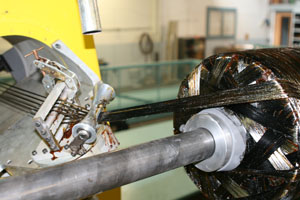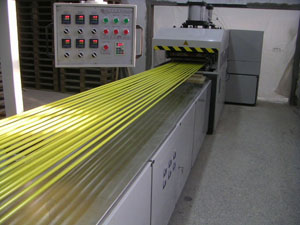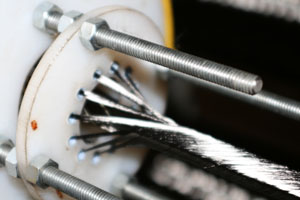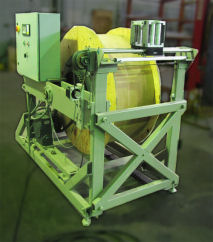Composite Manufacturing
Filament Winding
 Filament winding is a composite manufacturing method for creating closed form (usually circular) lay-ups. The process winds fibers under carefully controlled amounts of tension over a mandrel pre-form. As the mandrel rotates, the carriage moves left to right , laying down fibers in any angle or pattern desired. Glass and carbon are the most common filaments used. Typically, the filaments are pulled through a resin bath on their way to the mandrel, but fibers pre-impregnated with resin can also be easily used. After curing, the part is removed from the mandrel.
Filament winding is a composite manufacturing method for creating closed form (usually circular) lay-ups. The process winds fibers under carefully controlled amounts of tension over a mandrel pre-form. As the mandrel rotates, the carriage moves left to right , laying down fibers in any angle or pattern desired. Glass and carbon are the most common filaments used. Typically, the filaments are pulled through a resin bath on their way to the mandrel, but fibers pre-impregnated with resin can also be easily used. After curing, the part is removed from the mandrel.
LTI has specialized in utilizing very difficult to handle, ultra high modulus, pre-impregnated carbon fiber. Combined with highly sensitive (+/- 0.1 lb) bi-directional tension control, and precision fiber delivery systems, LTI has pushed the envelope of precise, repeatable filament winding. Our 4 axis winder has a 4 ft diameter x 6 ft length capacity, while our 5 axis winder can handle up to 8 ft diameter and 15 ft length. Both of LTI’s winders have been augmented with specially designed and built (in-house) equipment making them truly uniquely capable machines.
Pultrusion
 Pultrusion is a continuous process of manufacturing composites with a constant cross-section, where fibers are pulled through a resin injection port, and into a heated die, where the resin cross-links and hardens.
Pultrusion is a continuous process of manufacturing composites with a constant cross-section, where fibers are pulled through a resin injection port, and into a heated die, where the resin cross-links and hardens.
LTI has developed resin injection technology for the pultrusion process that ensures a quality product with extremely low void content. In this way, primary airframe structural elements have been developed which uniquely meet the specifications for weight, strength, and stiffness set for the next generation of commercial aircraft. Typical profiles are carbon fiber reinforced epoxy resin and LTI's extensive analytical and numerical optimization skills guarantee design for performance under all load cases. Resin injection technology also allows the use of high viscosity, difficult to handle, and unconventional resins such as elastomers and epoxy in pultrusion applications. Competitively priced solutions can be developed for your aerospace or industrial application.
Continuous Pull-Winding
 Pull-winding is an operation that can be added in-line with the pultrusion process to achieve superior composite properties. While traditional pultrusion relies on expensive textiles and fabrics to create bias-ply fiber lay-ups, pull-winding uses standard spools of fiber and can lay them down at any programmed angle. This allows for complete tailoring of the final part properties, and a reduction in final part cost vs. using fabrics.
Pull-winding is an operation that can be added in-line with the pultrusion process to achieve superior composite properties. While traditional pultrusion relies on expensive textiles and fabrics to create bias-ply fiber lay-ups, pull-winding uses standard spools of fiber and can lay them down at any programmed angle. This allows for complete tailoring of the final part properties, and a reduction in final part cost vs. using fabrics.
LTI’s two circ winders are both fully servo-controlled and slaved to the pull speed of the machine to ensure proper wind angles are maintained at all times. Each wheel of the winders are independently controlled and programmed, so any combination of angled plies is possible. This means most cross-sections can be torsionally balanced by design. Our large, 96 end, pull-winder is capable of complete coverage of parts up to 16 inches in perimeter.
Re-Spooling Capabilities
 LTI’s re-spooling capability allows us to make continuous, uninterrupted lengths of high strength profiles up to and beyond 5,000 feet long in an easily shippable package. Combined with fully automated meter mix systems and cutting edge resin injection, this also allows for hands free, around the clock operation with near 100% process yield. Well suited for, but not limited to, round cross-sections less than ¼ inch in diameter using glass or carbon fiber. Examples of products include ropes, tendons, re-bar, and re-enforced wire-lines.
LTI’s re-spooling capability allows us to make continuous, uninterrupted lengths of high strength profiles up to and beyond 5,000 feet long in an easily shippable package. Combined with fully automated meter mix systems and cutting edge resin injection, this also allows for hands free, around the clock operation with near 100% process yield. Well suited for, but not limited to, round cross-sections less than ¼ inch in diameter using glass or carbon fiber. Examples of products include ropes, tendons, re-bar, and re-enforced wire-lines.








